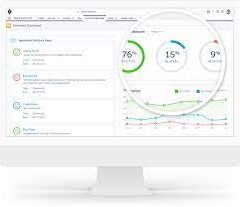Can AI-Driven Care Coordination Software Improve Workflows?
University Hospitals is leveraging AI technology across its network of hospitals and outpatient facilities to enhance care coordination and streamline patient care. Effective care coordination—organizing patient care across various providers—is essential to delivering safe, appropriate, and efficient treatments.
Improving communication among care teams can help patients avoid repeated lab tests, unnecessary appointments, and medication errors, according to the Centers for Medicare & Medicaid Services (CMS). Poor care coordination can result in negative health outcomes, increased emergency room visits, poor care transitions, and higher costs for patients.
According to the Agency for Healthcare Research and Quality (AHRQ), effective care coordination requires healthcare providers to adopt broad care delivery approaches, such as health IT, alongside more targeted strategies like proactive care planning based on patient needs. While electronic health records (EHRs) play a foundational role, emerging AI technologies promise to take care coordination to the next level by analyzing large datasets and facilitating more seamless workflows.
University Hospitals’ AI Initiative
In an interview, Donna Plecha, Chair of Radiology at University Hospitals, shared how the organization’s new AI-enabled care coordination software is helping improve patient outcomes without overburdening clinicians. University Hospitals, an early AI adopter, has previously used AI tools in intensive care units to screen for lung conditions and locate medical devices on portable X-rays.
This year, University Hospitals partnered with Aidoc, deploying its AI platform, aiOS, across 13 hospitals and numerous outpatient centers. The pilot phase includes testing Aidoc’s FDA-approved AI algorithms for radiology, triage, and care coordination. Once data from the pilot phase is evaluated, the health system will identify opportunities for additional AI integration in clinical workflows.
Addressing Workflow Challenges with AI
Plecha noted that radiologists are often stretched thin by high patient volumes, which can lead to clinician burnout. AI-driven tools can ease the workload by handling routine tasks, enabling radiologists to focus on more critical aspects of patient care. For example, AI can help clinicians prioritize patients with urgent needs, flagging cases that require immediate attention.
Plecha emphasized that the fear of AI replacing radiologists is unfounded; rather, radiologists who collaborate with AI tools are likely to enhance their effectiveness and job security. Research shows promising results when radiologists work with AI in decision support, compared to when either works alone.
Currently, University Hospitals is using Aidoc’s pulmonary embolism screening tool to detect subtle blood clots in the lungs, a condition that can be life-threatening if missed. AI’s support in such screenings can enhance care coordination, though Plecha advises implementing AI tools cautiously, balancing their insights with clinical expertise.
Identifying and Integrating AI Use Cases
Plecha noted that selecting organization-specific AI use cases is crucial to maximizing value. Talking with other healthcare providers about successful tools helps University Hospitals identify high-value applications that fit within its existing workflows. This internal audit also avoids redundant investments by noting where AI is already in use, such as for pneumothorax and intracranial hemorrhage screening.
The integration process also involves collaboration between IT and health informatics teams to evaluate how new AI tools align with existing workflows. For University Hospitals, this means assessing how tools interact with systems like the picture archiving and communication system (PACS) to streamline radiologist workflows.
Testing and Monitoring
Once a tool passes architectural reviews and integrates into clinical workflows, it undergoes pilot testing, after which data can be gathered to evaluate the tool’s impact on workflow efficiency and ROI.
Measuring AI’s Impact on Care Coordination
According to Plecha, measuring ROI for AI tools varies based on workflow and application. For example, assessing AI’s effect on pulmonary embolism detection includes metrics such as the number of true and false positives, and any changes in detection rates over time. In the case of AI-enabled pneumothorax screening, metrics like “time to treatment” highlight AI’s role in accelerating care.
Clinician buy-in and satisfaction are also critical. Plecha stressed the importance of feedback loops with clinicians, as insights from the care team inform ongoing improvements.
“For radiologists worried about being replaced: the one who isn’t replaceable is the one interacting with AI,” Plecha remarked. She concluded that, in the face of radiologist shortages, tools that reduce workload and enhance efficiency are essential. “We have to move forward with technology that lightens the load, so clinicians can focus on delivering high-quality care.”
🔔🔔 Follow us on LinkedIn 🔔🔔









